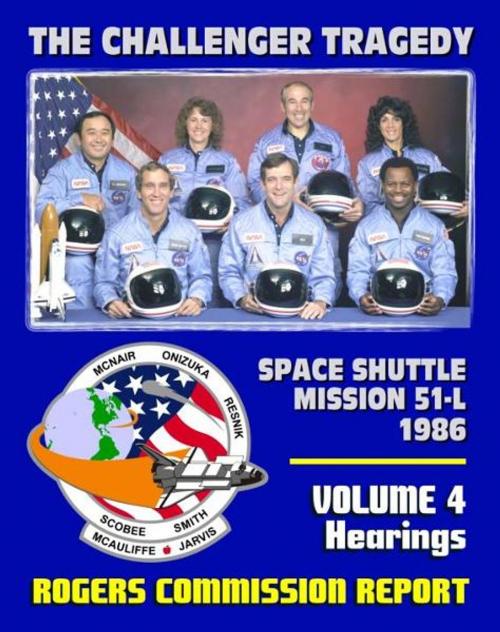The Report of the Presidential Commission on the Space Shuttle Challenger Accident - The Tragedy of Mission 51-L in 1986 - Volume 4 Hearings (February 6 - 25, 1986)
Nonfiction, Science & Nature, Science, Physics, Astrophysics & Space Science, History, Americas| Author: | Progressive Management | ISBN: | 9781466017696 |
| Publisher: | Progressive Management | Publication: | January 30, 2012 |
| Imprint: | Smashwords Edition | Language: | English |
| Author: | Progressive Management |
| ISBN: | 9781466017696 |
| Publisher: | Progressive Management |
| Publication: | January 30, 2012 |
| Imprint: | Smashwords Edition |
| Language: | English |
Volume Four of the report issued by the Presidential Commission on the Space Shuttle Challenger Accident (also known as the Rogers Commission after its chairman, William Rogers) contains the transcripts of hearings conducted from February 6 through February 25, 1986. The report has been professionally converted for accurate flowing-text ebook format reproduction. This reproduction includes testimony from NASA officials and managers describing the Shuttle program, the Challenger mission, and the circumstances of the accident, plus crucial testimony from Thiokol engineers about the pre-launch controversy over proceeding with the launch in cold temperatures that could affect the performance of Solid Rocket Booster O-rings. Richard C. Cook testified about his memos months before the accident warning of a possible catastrophe, which had been leaked to the New York Times. Thiokol engineer Roger Boisjoly revealed that he and other Thiokol engineers warned managers about the risks of the planned launch.
The sessions in this document:
FEBRUARY 6, 1986 SESSION * William R. Graham * Jesse W. Moore * Arnold A. Aldrich * Judson A. Lovingood * Robert Sieck * Thomas L. Moser * Richard H. Kohrs
FEBRUARY 7, 1986 SESSION * Marv Jones * Stanley Kline * Jesse W. Moore and Arnold D. Aldrich
FEBRUARY 10, 1986 SESSION * L. Michael Weeks and Irvin Davids * Lawrence B. Mulloy
FEBRUARY 11, 1986 SESSION * William R. Graham * Jesse W. Moore * Lawrence B. Mulloy * Richard C. Cook * Michael B. Mann * David Winterhalter
FEBRUARY 13, 1986 SESSION * Richard Kohrs * Charles Stevenson * W. Lucas, J. Moore, M. Silveira, G. Hardy, H. Lamberth and J. Harrington * Jack Lee * George Hardy * Richard Bachtel * Thomas Moser
FEBRUARY 14, 1986 SESSION * Lawrence B. Mulloy * Jerry Mason * Robert Lund * Roger Boisjoly * Arnold Thompson * Allan McDonald
FEBRUARY 25, 1986 SESSION * Allan McDonald * Jerry Mason * Roger Boisjoly and Arnold Thompson * Robert Lund, Joe Kilminster and Brian Russell
On the twenty-fifth Space Shuttle flight, Challenger exploded 73 seconds after
liftoff on January 28, 1986. The crewmembers of the Challenger represented a cross-section of the American population in terms of race, gender, geography, background, and religion. Christa McAuliffe was to become the first teacher to fly in space. The explosion became one of the most significant events of the 1980s, as billions around the world saw the accident on television and empathized with any one of the several crewmembers killed. The launch took place on an unusually cold day, with temperatures below freezing and ice present on the launch pad and SRBs. NASA and the SRB contractor, Morton Thiokol, debated the safety of the launch; engineers urged managers to delay the launch. President Ronald Reagan formed this Commission to investigate the accident, with the report issued in June 1986.
In view of the findings, the Commission concluded that the cause of the Challenger accident was the failure of the pressure seal in the aft field joint of the right Solid Rocket Motor. The failure was due to a faulty design unacceptably sensitive to a number of factors. These factors were the effects of temperature, physical dimensions, the character of materials, the effects of reusability, processing, and the reaction of the joint to dynamic loading. The Commission concluded that there was a serious flaw in the decision making process leading up to the launch of flight 51-L. A well-structured and managed system emphasizing safety would have flagged the rising doubts about the Solid Rocket Booster joint seal. Had these matters been clearly stated and emphasized in the flight readiness process in terms reflecting the views of most of the Thiokol engineers and at least some of the Marshall engineers, it seems likely that the launch of 51-L might not have occurred when it did.
Volume Four of the report issued by the Presidential Commission on the Space Shuttle Challenger Accident (also known as the Rogers Commission after its chairman, William Rogers) contains the transcripts of hearings conducted from February 6 through February 25, 1986. The report has been professionally converted for accurate flowing-text ebook format reproduction. This reproduction includes testimony from NASA officials and managers describing the Shuttle program, the Challenger mission, and the circumstances of the accident, plus crucial testimony from Thiokol engineers about the pre-launch controversy over proceeding with the launch in cold temperatures that could affect the performance of Solid Rocket Booster O-rings. Richard C. Cook testified about his memos months before the accident warning of a possible catastrophe, which had been leaked to the New York Times. Thiokol engineer Roger Boisjoly revealed that he and other Thiokol engineers warned managers about the risks of the planned launch.
The sessions in this document:
FEBRUARY 6, 1986 SESSION * William R. Graham * Jesse W. Moore * Arnold A. Aldrich * Judson A. Lovingood * Robert Sieck * Thomas L. Moser * Richard H. Kohrs
FEBRUARY 7, 1986 SESSION * Marv Jones * Stanley Kline * Jesse W. Moore and Arnold D. Aldrich
FEBRUARY 10, 1986 SESSION * L. Michael Weeks and Irvin Davids * Lawrence B. Mulloy
FEBRUARY 11, 1986 SESSION * William R. Graham * Jesse W. Moore * Lawrence B. Mulloy * Richard C. Cook * Michael B. Mann * David Winterhalter
FEBRUARY 13, 1986 SESSION * Richard Kohrs * Charles Stevenson * W. Lucas, J. Moore, M. Silveira, G. Hardy, H. Lamberth and J. Harrington * Jack Lee * George Hardy * Richard Bachtel * Thomas Moser
FEBRUARY 14, 1986 SESSION * Lawrence B. Mulloy * Jerry Mason * Robert Lund * Roger Boisjoly * Arnold Thompson * Allan McDonald
FEBRUARY 25, 1986 SESSION * Allan McDonald * Jerry Mason * Roger Boisjoly and Arnold Thompson * Robert Lund, Joe Kilminster and Brian Russell
On the twenty-fifth Space Shuttle flight, Challenger exploded 73 seconds after
liftoff on January 28, 1986. The crewmembers of the Challenger represented a cross-section of the American population in terms of race, gender, geography, background, and religion. Christa McAuliffe was to become the first teacher to fly in space. The explosion became one of the most significant events of the 1980s, as billions around the world saw the accident on television and empathized with any one of the several crewmembers killed. The launch took place on an unusually cold day, with temperatures below freezing and ice present on the launch pad and SRBs. NASA and the SRB contractor, Morton Thiokol, debated the safety of the launch; engineers urged managers to delay the launch. President Ronald Reagan formed this Commission to investigate the accident, with the report issued in June 1986.
In view of the findings, the Commission concluded that the cause of the Challenger accident was the failure of the pressure seal in the aft field joint of the right Solid Rocket Motor. The failure was due to a faulty design unacceptably sensitive to a number of factors. These factors were the effects of temperature, physical dimensions, the character of materials, the effects of reusability, processing, and the reaction of the joint to dynamic loading. The Commission concluded that there was a serious flaw in the decision making process leading up to the launch of flight 51-L. A well-structured and managed system emphasizing safety would have flagged the rising doubts about the Solid Rocket Booster joint seal. Had these matters been clearly stated and emphasized in the flight readiness process in terms reflecting the views of most of the Thiokol engineers and at least some of the Marshall engineers, it seems likely that the launch of 51-L might not have occurred when it did.















